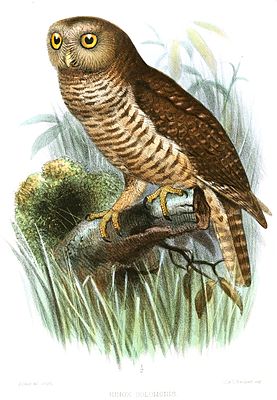New Ireland owl
| New Ireland owl | ||||||||||
|---|---|---|---|---|---|---|---|---|---|---|

New Ireland owl ( Ninox variegata ) |
||||||||||
| Systematics | ||||||||||
|
||||||||||
| Scientific name | ||||||||||
| Ninox variegata | ||||||||||
| ( Gaimard & Quoy , 1830) |
The New Ireland owl ( Ninox variegata ), also known as Bismarck owl, is a species of owl from the genus of the bush owl ( Ninox ). In addition to the nominate form Ninox variegata variegata from New Ireland and New Britain, there is also the subspecies Ninox variegata superior from Lavongai .
features
The New Ireland owl reaches a size of 23 to 30 centimeters. In the nominate form, the wing length is 192 to 210 mm and the tail length is 117 to 118 mm. The face veil is brown. The head is often more grayish-brown in color than the coat. The ear covers are gray-brown or brown. The top is dark reddish brown and more or less faint light or dark reddish speckles. The coat is almost unmarked. The shoulders and wing covers show small white shaft stripes and spots. The hand and arm wings are brown with white spots, which are arranged in five rows. The alula is dark reddish brown. The tail is dark reddish-brown with ocher-yellow-brown bands. The underside is white with clear, scale-shaped, dark reddish-brown (in the dark color morph ) and orange-reddish (in the light color morph) shaft stripes. The neck is densely marked and therefore appears darker than the chest and stomach. The barrel is feathered at the base of the toes. The toes have bristle hair. The eyes are yellow. The beak is yellowish horn-colored with a light tip. The toes are dull yellow. The claws are dark horn-colored. The subspecies Ninox variegata superior is slightly larger than the nominate form. The wing length is 211 to 224 mm. The top is lighter brown. The forehead shows some speckles. The face is lighter. The mantle, the wings and the back are characterized by clear spots and shaft stripes. There is a large spot on the throat. The underside is light with fine brown shaft stripes on the belly.
distribution and habitat
The New Ireland owl inhabits forests in the lowlands as well as hill and mountain forests at lower and medium altitudes of up to 1000 m. It occurs on the islands of New Ireland , New Britain and Lavongai in the Bismarck Archipelago .
Way of life
Little research has been done into his way of life. It is nocturnal and feeds mainly on insects. A young bird that had just fledged was observed in April.
status
The New Ireland Owl is fairly common in and around forests. It is widespread and is classified by the IUCN as “not at risk” (least concern).
literature
- J. Del Hoyo, A. Elliot, J. Sargatal (Eds.): Handbook of the Birds of the World. Volume 5: Barn-Owls to Hummingbirds. Lynx Edicions, 1999, ISBN 84-87334-25-3 .
- Claus König, Friedhelm Weick: Owls of the World. 2nd Edition. Christopher Helm, London 2008, ISBN 978-0-7136-6548-2
Web link
- Ninox variegata inthe IUCN 2013 Red List of Threatened Species . 2. Listed by: BirdLife International, 2012. Retrieved February 6, 2014.